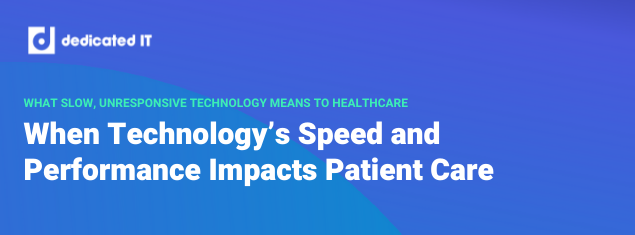When Technology’s Speed and Performance Impacts Patient Care
How Can IT Solve Speed and Performance Issues?
We’ve all been there – that frustrating moment of waiting for your keyboard to catch up with your typing, watching an application load at a snail’s pace, or patiently sitting at your desk waiting for the Internet to come back on. What’s the root cause of technology being slow to respond? How can you identify and fix speed and performance issues?
Let’s take a look at the healthcare sector and how the speed and performance of technology can delay patient care or impact the bottom line.
When Speed and Performance Become a Company-Wide Pain Point
Your organization experiences a decline in speed and performance any time a device, application, browser, or network is unresponsive or slow to respond. It’s an IT pain point that can be pretty specific based on what an organization does, but common scenarios are:
- Computers take a long time to boot into OS
- Applications or browsers take a long time to load
- Computers are slow to respond to clicking, typing, or touching
- Device reset or shutdown takes a while
- Internet constantly goes out
When an employee or a customer becomes annoyed or due to slow or unresponsive technology or it’s impacting the bottom line in some way, IT is typically the first to hear about it and is tasked with finding a solution.
Speed and performance issues in technology is about as frustrating as sitting in traffic. You know you’re stuck, but you don’t know why. If you want to do something about it, you need to understand what the source of the traffic is. It is construction or an accident? Typical rush hour or congestion from a concert?
What Slow and Unresponsive Technology Means to Healthcare
The speed and performance of technology is essential to healthcare practices, for both employees and patients. When a workstation is running slowly, that might prevent a nurse from clocking out on time or moving onto new tasks. When scheduling tools are unresponsive, patients experience long wait times when they can’t afford to sit on hold.
Think about the vast amount of technology required for any type of healthcare practice. There are patient portals, EMRs, telehealth software, imaging, communication or collaboration tools, and even something as simple as the Internet. Technology speed and performance is critical in healthcare because so much depends on it, from everyday tasks to live-saving procedures.
How to Improve Speed and Performance
We believe in a two-part approach to solving speed and performance issues.
First, you have to understand what is slow. Is it slow to respond, or completely useless? Is it the machine or the Internet? Is it the software or the device? Is it happening at one workstation or all of them? This may seem like a basic concept, but you can’t fix speed and performance issues without knowing the cause. A technologist must be able to listen to someone explain their speed and performance complaint and discern the real problem, not the perceived problem. Walking into a situation with a “fix-it” mindset might not solve the root cause, which is most important.
Second, you have to get real: it is a technology problem or a people problem? A technology problem are things like bugs, updates, or replacements. There’s nothing that the user is wrong, it’s literally a technical issue that needs a fix. People problems are more common than you might think. A people problem might look like a lack of training or adoption – we’ve all had coworkers who don’t take IT training seriously or refuse to implement new processes. Or maybe technology just isn’t functioning as the user expected it to, but their expectations were misaligned to begin with.
Say, for instance, an employee reports that they’re experiencing a slow EMR. They might ask your IT department or managed service provider if this is normal, especially in comparison to other users of this EMR. It’s the technologist’s job to figure out what is slow – the EMR? Or the network that the EMR is running on? Could it be a cloud issue? What about the machine the EMR is running on? Is the user using the EMR correctly?
This two-part approach will solve IT tickets efficiently and effectively. If your technologists cannot determine what is causing speed and performance to decline and whether it’s a technology problem or a people problem, you might not have the right type of technologists on staff. They need to know your staff, understand how your staff uses technology, and honor the importance of IT speed and performance.
At the end of the day, your practice is trying to deliver quality, efficient patient care and if you have problems with the speed and performance of your system and processes, you won’t be able to do that. That’s where Dedicated IT can help. With our suite of IT services, robust healthcare-specific knowledge and our two-step approach, we can take the frustration out of speed and performance issues at your practice, allowing you to shift your focus on providing excellent patient care. Don’t wait until your next outage. Contact us today to get started.


